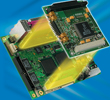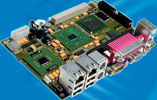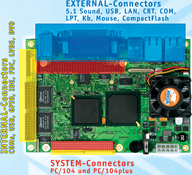
To date, a development path for PCI Express has been lacking for the smallest stackable SBC form factor, the PC/104. However, increased efforts to arrive at an official standard approved by the consortium are now underway and publication of the specification is expected in 2007. Therefore, PC/104 I/O providers and end-users still have to be patient a little longer, until the standard is officially adopted, in order to protect their investments.
PC/104 is one of the oldest form factors for single-board computers: it was adopted in 1992 and was a hit with users thanks to its particularly small footprint and stackable expansion cards, which allow run-capable embedded designs to be put together quickly. The design of PC/104, which was originally based on the ISA bus had 104 pins. It was later expanded to include PCI and this standard was named PC/104-Plus. At the end of 2003, the consortium, which had grown to include over 75 members, adopted the PCI-104 standard for purely PCI-based solutions. This became necessary when the chipset manufacturers finally removed ISA from the chipsets' support programs.
However, PCI-104 never really caught on, because PCI-to-ISA bridges soon became available, so the installed PC/104-Plus base never had to switch paths. PC/104-Plus is also a master key for many I/O expansions on single-board computers as no other expansion design has been implemented so successfully on almost every SBC form factor: PC/104-Plus expansion slots are found not just on PC/104 and PC/104-Plus CPU boards, but also on 5,25", EBX, 3,5", EPIC, and PICMG solutions. Even flat 19-inch systems have been built based exclusively on PC/104-Plus, to name just one of many occasionally exotic solutions. This is the strength of a uniform design, which was introduced to the market early on: it gives providers security in developing their I/O products and users the security of a wide choice of compatible products.
In March 2004, EPIC was defined as a motherboard standard which could accept PC/104-Plus or PCI-104 expansion assemblies. The current Version 2.0 was published in February, 2006. The advantages: even the fastest processors and chipsets today can be used, there is more space available, connections for external devices can be installed directly onto the board, and the thermal design within the expansion card stack is simpler. However, neither EPIC nor PCI-104 are big sellers in the market, because the new designs were mostly only adopted by the existing PC/104 community; new customers were seldom added because PC/104 was seen as outdated. For example, with JRex/JFLEX, Kontron created a new form factor which no longer used the PC/104 pressfit connector and also planned the connection of external plugs for the expansion cards.
With the implementation of PCI Express, the PC/104 community sensed an opportunity. The reduced number of circuit paths - possibly 32 with PCI for just one bi-directional PCIx1 lane on the expansion assembly - creates an enormous amount of space and is ideal for the development of similar small and compact expansion assemblies in the stack principle. As a result, the established PC/104 design could undergo a complete revival accompanied by the ULV high-end processors, which can be operated without fans and are being manufactured with increasingly small processor footprints, so that again the smallest CPU-board form factors will be possible in the ULV area.
Pursuing these opportunities, two designs by consortium members are currently in circulation: a standard design for EPIC-Express from several American companies, which has already been submitted for standardisation in the consortium, and a design for PC/104-express which was recently introduced by a few European companies and, according to statements, will also be submitted for standardisation.
Putting these two designs together however, does not produce a single picture. While the EPIC-express design plans an expansion assembly and has already integrated many functions on the EPIC motherboard, the design for PC/104-express is still based on the option of being able to plug several expansion assemblies into each other; therefore, the two specifications do not fit together, which does not make the standardisation process easy. So, the aim is ultimately to reconcile the two approaches because there should be a uniform mechanical and electrical approach for the next generation of PC/104 so that providers and users continue to receive the advantageous security in product development and selection mentioned above. But what the end result will be is not yet certain.
Certainly, it would be good for the development path from PC/104 and PC/104-Plus to PC/104-express if the ability to stack modules is retained, because that is one of the biggest advantages of the form factor, along with the small footprint. However, without corresponding EPIC motherboards, there would be a division of the standard, which would not be of advantage to either camp. For this reason, an agreement must be reached and an official specification for both standards defined, representing not a weak compromise between the positions, but a real migration path for I/O manufacturers and users of PC/104.
For example, if the new specification succeeds in implementing a fully SMT-capable design for PC/104-express, thus finally putting an end to pressfit, and also using these connectors for EPIC, both groups of CPU-board manufacturers would have to change their designs completely. On the other hand, a standard would be created that could allow the PC/104 era to begin anew. This step could be compared to the jump from ETX to ETXexpress (or COM Express according to the PICMG nomenclature). Intermediate steps were not defined here either. Of course, the same is true of PICMG 1.x to PICMG 2.x to PICMG 3.x etc. So why not just put an end to all of the outdated practices at once and develop a completely new stackable SBC design using the wealth of experience of all the consortium members? Such a solution would not carry any disadvantages for existing I/O-board manufacturers, since even ISA-based expansions are possible via the appropriate bridges. Thus, PC/104 would be suitable for ISA, PCI, and PCI Express, and the subject of long-term availability for embedded computer technology would be emphasised in a previously unheard-of form. However, the resulting new PC/104 specification is also interesting when viewed impartially: the smallest SBC standard would be reborn and also be of interest for the latest developments with finished CPU and expansion boards in the smallest possible space.
As long as the consortium has still not made a decision on PCI Express for PC/104 and EPIC, Kontron will not take the initiative, for example, in suggesting an alternative. As one of the world's leading PC/104-Plus CPU-board providers, the company will restrict itself to its function on the technical committee of the consortium and will push forward the standardisation there as expeditiously as possible. Therefore, comments on the current developments should not be taken as evaluation of one design or another, but should operate internally and externally - to the benefit of customers and I/O partners. If a solution that fits all is adopted, Kontron, and probably all other market participants as well, will hit the ground running with PC/104-express and EPIC-express. However, until a standard is adopted, development is limited to the design of assemblies in accordance with the present standard.
Newly added to Kontron's range is the EPIC-PM board with Intel Pentium M processor, which, with the launch of dual-core, fits ideally in PC/104-Plus applications in terms of price/performance ratio, thus opening up a high market potential. With the deferred launch of this Intel Pentium M design, Kontron also underscores the market position of PC/104 and EPIC as a low-price/high-volume solution, which does not always have to offer the highest performance, but delivers reliable solutions for many common standard applications.
Latest EPIC board for standard PC/104 I/O assemblies
At Embedded World 2007, Kontron will introduce the EPIC/PM single board computer (SBC), the second board for the standard officially confirmed by the PC/104 consortium. It is based on the 90 nm Intel Pentium M processor 745 and offers full PC/104-Plus functionality with PCI as well as ISA bus. Furthermore, their physical interfaces are standardised for the internal and external connection of peripherals, which significantly simplifies the scalability of the performance, since the housing does not have to be mechanically altered.

Besides full PC/104(-Plus) support with ISA and PCI bus and uniform physical design for all relevant internal and external connections, Kontron's EPIC/PM is impressive thanks to its Pentium M 745 processor with 1,8 GHz and 2 MB L2 cache. The advantage of this processor is its higher speed without higher power consumption. Alternatively, the board is available with the ULV Celeron M 373 (1 GHz) or the Intel 800 MHz processor, which is ideal for cost-sensitive applications.

For the connection of external peripherals, the EPIC/PM offers a number of connectors on the front side: it includes four USB 2.0 interfaces, two 10/100 Base-T Ethernet interfaces, keyboard, mouse, CRT, 5.1 Sound, LPT, and a serial interface. All of these functions correspond to those of a desktop PC and are economically implemented in a single block. Moreover, there is also a CompactFlash slot on the front side. Additional interfaces, which can be installed as needed, are two more USB 2.0 interfaces, three more COM ports, eight GPIO pins, and the usual interfaces for standard 3,5" EIDE hard drive, CompactFlash slot, and removable memory media. The RAM can be expanded up to 2x 1 GB DDR-RAM-SODIMM (dual socket).

CRT and LCD support with 2x 24Bit LVDS is provided by the Intel Extreme Graphics 2 engine integrated into the chipset with up to 2x32 MB video RAM - this allows the operation of dual independent flat displays. DVO support and interface are also offered. The LVDS interface is implemented via JILI. JILI is a universally functional adapter available for all standard panels. Thus, OEMs can choose the appropriate display for their application without having to worry about the compatibility of the panel interface.
Watchdog, realtime clock, LanBoot, and DarkBoot round out the feature set. These features are part of EVA, the free on-board software tool suite on every EPIC. EVA (Embedded Value Add) simplifies the installation, maintenance, and use of the product, and is a component of all Kontron EPIC products.
For more information contact Martin Bodenschatz, Kontron Embedded Modules, +49 (991) 37024703, [email protected]
© Technews Publishing (Pty) Ltd | All Rights Reserved